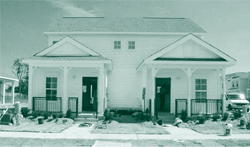June 2008
In this Issue
Black Colleges and Universities Lend a Helping Hand
Learning To House the Homeless
Researching HUD's Housing Programs
What We Know About LIHTCs
In the next issue of ResearchWorks
What We Know About LIHTCs
HUD's Office of Policy Development and Research (PD&R) has released an update of the Low-Income Housing Tax Credit (LIHTC) Database to include LIHTC-financed housing projects placed in service through 2005. This database is the only comprehensive source of information on the federal government's largest subsidy program for the construction and rehabilitation of low-income rental housing. Although HUD does not administer the program, its importance as a funding source for low-income housing has led PD&R to collect and regularly update information about LIHTC projects.
The database at http://lihtc.huduser.gov includes the project address, number of units and low-income units, number of bedrooms, year the tax credit was allocated, year the project was placed in service, whether the project was new construction or a rehabilitation, type of tax credit provided, and other sources of project financing. The information is geocoded, enabling researchers to look at both the geographical distribution and neighborhood characteristics of LIHTC projects.

About LIHTCs
The Tax Reform Act of 1986 created the LIHTC program to stimulate the production of rental housing targeted to lower income households. Fifty-eight state and local agencies have authority to issue federal tax credits for the acquisition, rehabilitation, or construction of affordable rental housing. The credits allow property owners to reduce federal income taxes and are generally taken by outside investors who contribute initial development funds for a project. To qualify for credits, a housing project must have a specific proportion of its units set aside for lower income households, with unit rents limited to a maximum of 30 percent of the eligible income (50 or 60 percent of area median income).
The amount of tax credits provided for a project is a function of the development cost (excluding land), the proportion of affordable units set aside, and the credit rate (which varies based on the development method and whether other federal subsidies are used). Credits are designed to provide benefits with a present value equal to either 30 or 70 percent of a property’s qualifying basis. The 30-percent tax credit is for acquisition or for federally financed rehabilitation and new construction. The 70-percent tax credit is for nonfederally financed rehabilitation or construction.
In 1989, as part of the Omnibus Reconciliation Act, Congress added provisions to the LIHTC program to encourage production of affordable housing units in hard-to-serve areas. Specifically, the act permits projects located in Difficult Development Areas (DDAs) or Qualified Census Tracts (QCTs) to claim 30 percent more in tax credits than identical projects outside of these areas. Designated by HUD, DDAs are metropolitan or nonmetropolitan areas in which construction, land, and utility costs are high relative to incomes; QCTs are census tracts in which at least half of the households have incomes that are less than 60 percent of the area median income or have a poverty rate of at least 25 percent.
LIHTCs at Work, 1995–2005

PD&R's LIHTC Database documents 27,410 projects and 1.53 million units placed in service between 1987 and 2005. The best data coverage available is for the period 1995 – 2005, when all 58 tax credit-allocating agencies provided the most complete data.
Almost 1,400 LIHTC projects containing 100,000 housing units entered service annually during this period. Of these projects:
-
The average size was 73 units;
-
Most (83 percent) were composed almost entirely of low-income units;
-
Nearly two-thirds were new construction, with the remaining third being rehabilitated existing structures;
-
29 percent were sponsored by nonprofit organizations;
-
Less than two-thirds (63 percent) were financed with 70-percent credits and nearly 29 percent used 30-percent credits; and
-
21 percent were located in DDAs and 29 percent in QCTs.
These projects were disproportionately located in metropolitan areas and nonmetropolitan counties where development costs are low relative to incomes. Projects located in DDAs and QCTs were more likely to be rehabilitated projects and to have nonprofit sponsors, compared with projects in nondesignated areas.
These statistics and others are derived from the report HUD National Low-Income Housing Tax Credit (LIHTC) Database: Projects Placed in Service Through 2005, available for download at www.huduser.gov/Datasets/lihtc/tables9505.pdf.

